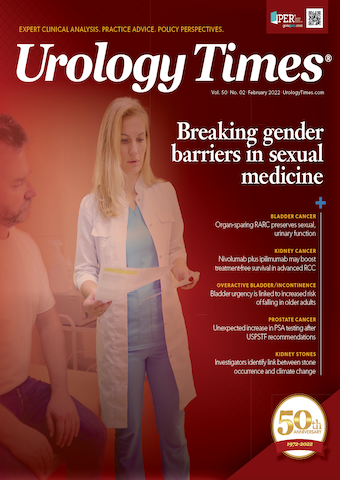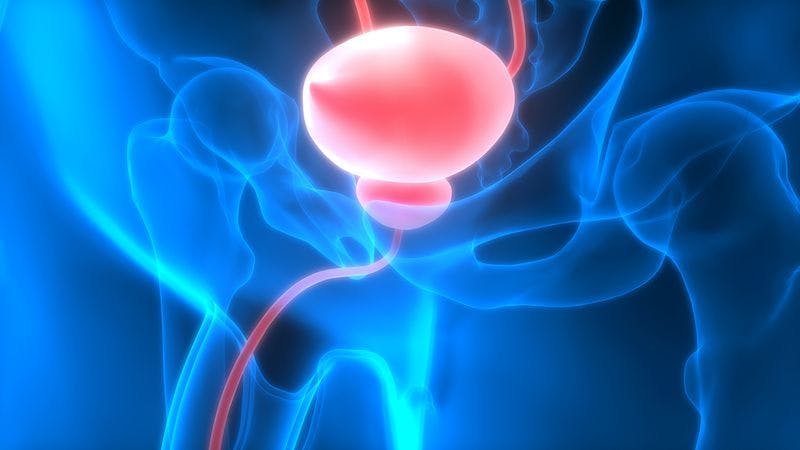Publication
Article
Urology Times Journal
Female organ-sparing robotic cystectomy preserves sexual, urinary function
Author(s):
A retrospective study presented at the 2021 Society of Urologic Oncology Annual Meeting showed that a majority of women with urothelial cancer who received pelvic organ–preserving robot-assisted radical cystectomy (RARC) with intracorporeal urinary diversion were able to return to sexual activity post-surgery without compromising oncological outcomes.1
In a virtual presentation shared during the meeting, study author Etienne Lavallee, MD, a urology fellow at the Icahn School of Medicine at Mount Sinai, said that the multicenter retrospective analysis included sexually active females undergoing pelvic organ–preserving RARC. Women had ≤pT2, N0, M0 urothelial cancer as determined by examination, imaging, and pathological staging. All patients had unifocal tumors away from the bladder base. Patients were excluded from the analysis if they had multifocal, trigonal, or locally advanced disease (>cT2) with potential internal genital organ involvement.
Sexual and urinary function after surgery was the primary study end point. To evaluate this end point, patients completed a sexual function questionnaire and the investigators used patient records from follow-up visits to assess urinary function. Secondary end points included perioperative and oncological outcomes.
Overall, the study included 23 female patients who underwent pelvic organ–preserving RARC. The surgeries were performed at 2 academic institutions between 2008 and 2020. Twenty (87%) patients underwent intracorporeal neobladder reconstruction and 3 (13%) patients received Ileal conduit urinary diversion.
The median patient age was 54 years (range, 34-79) and the median BMI was 23.6 kg/m (range, 18.2-33.1). Twelve patients were current smokers, 7 were former smokers, and 4 were never-smokers. The clinical stages were Tis/Ta/T1 (n = 10) and T2 (n = 13); the pT stages were T0 (n = 11), Tis/Ta/T1 (n = 2), T2 (n = 7), and T3 (n = 3); and the pN stages were pN0 (n = 19) and pN1(n = 3).
Seven patients had prior BCG and 13 had neoadjuvant chemotherapy. The average operating time was 300 minutes (range, 250-390 minutes) and the average hospital stay was 6 days (range, 3-16). Eight patients had grade 1/2 surgical complications. There were no grade 3 to 5 surgical complications.
At a median follow-up of 20 months (range, 7-151), about two-thirds (65%; n= 15) of the patients completed the postoperative sexual function questionnaire. Of these patients, 87% (n = 13) resumed sexual activity within a median time of 6 months following surgery. Of these 13 patients, 8% (n = 1), 54% (n = 7), and 38% (n = 5) reported having low, moderate, and high levels of sexual activity, respectively. Orgasm during sexual activity was able to be achieved by all of the sexually active patients.
“Of the 10 patients who participated in penetrative intercourse, only 1 had occasional pain,” noted Lavallee.
Among patients who received neobladder reconstruction, 70% (n = 14) achieved daytime continence and 80% (n= 16) achieved nighttime continence.
“Half of the patients who underwent neobladder needed occasional clean intermittent catheterization,” added Lavallee.
Four (17%) patients had disease recurrence. The median time to recurrence was 13 months (range, 11-28). The recurrence-free survival rate was 83%. The cancer-specific survival and overall survival rates were both 91%. Two patients died of bladder cancer at 20 and 36 months, respectively.
“Of note, only 1 patient had a positive surgical margin, located at the left ureter. This was not considered to be due to the selection of an organ-preserving approach,” said Lavallee.
In his concluding remarks, Lavallee said, “Pelvic organ–preserving robot-assisted radical cystectomy with intracorporeal urinary diversion should be considered in selected sexually active women who wish to preserve sexual function after surgery.
Reference
1. Etienne Lavallee E, Dovey Z, Pathak P, et al. Female pelvic organ preserving robot-assisted radical cystectomy; functional outcomes of a modern robotic technique. 2021 Society of Urologic Oncology Annual Meeting. December 1-3, 2021; Orlando, FL. Abstract 52.

Newsletter
Stay current with the latest urology news and practice-changing insights — sign up now for the essential updates every urologist needs.





























